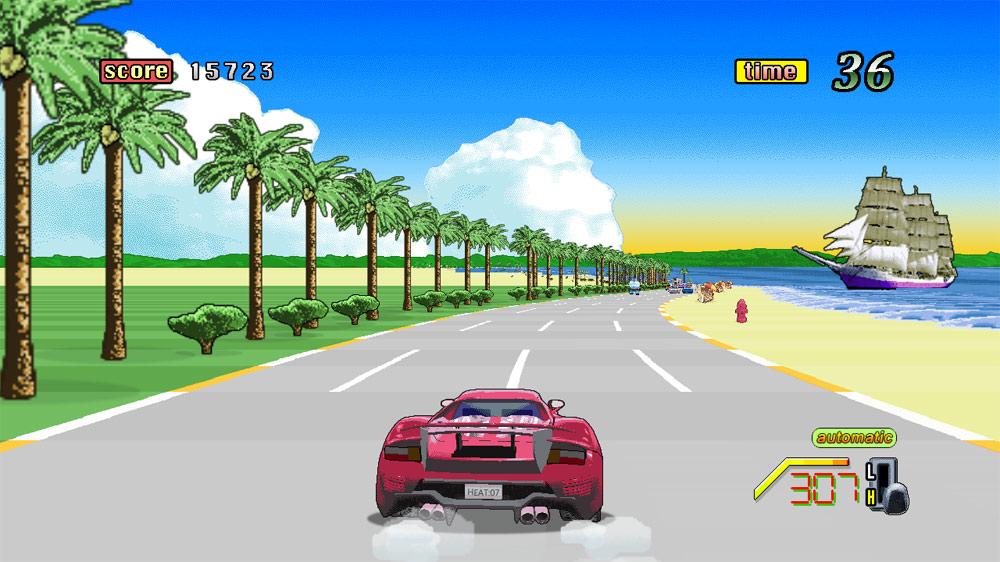When Sega released Out Run in 1986, the game quickly became one of the most iconic arcade racers of all time. Unlike earlier racing games, Out Run wasn’t about crossing a finish line—it was about the experience: cruising in a red sports car, listening to smooth background music, and enjoying vibrant scenery. At the heart of this immersive design was the Out Run car sprite—a graphical element that defined the look and feel of the game.
This article explores the history, design, and cultural impact of the Out Run car sprite, and why it remains one of the most memorable visuals in gaming history.
The Significance of Sprites in Retro Gaming
Before 3D graphics, most games relied on sprites, or 2D images used to represent characters, vehicles, and objects. In Out Run, sprites were essential for creating the illusion of movement and depth. The roadside trees, traffic vehicles, and the player’s car were all sprite-based. The game’s car sprite wasn’t just decoration—it was the centerpiece of the experience.
Sega’s Vision for Out Run
Sega wanted Out Run to stand out from traditional racing games like Pole Position. Instead of focusing on competition, they created a game that felt more like a driving adventure. To achieve this, they needed a stylish, recognizable car sprite that players would immediately associate with freedom, speed, and luxury.
The Ferrari Testarossa Inspiration
The Out Run car sprite was heavily inspired by the Ferrari Testarossa, one of the most famous sports cars of the 1980s. Though Sega never officially licensed the vehicle, the resemblance was clear—sleek lines, low profile, and an unmistakable red finish. This choice gave the game instant aspirational appeal, allowing players to imagine themselves behind the wheel of a dream car.
Sprite Design and Animation Techniques
Creating the Out Run car sprite required clever use of pixel art. Developers had to balance limited resolution and color palettes while still conveying detail and movement. Techniques included:
- Scaling Sprites – To simulate forward motion, the car and road objects grew larger as they approached the screen.
- Pixel Shading – Subtle color variations gave the sprite depth and shine.
- Frame Animation – The sprite included slight shifts to simulate turning, braking, and skidding.
These techniques gave the car a dynamic and realistic feel despite hardware limitations.
Player Interaction with the Car Sprite
The Out Run car sprite wasn’t static—it changed based on the player’s driving. Actions that affected the sprite included:
- Turning Left or Right – The car tilted slightly in the chosen direction.
- Crashes – The car sprite dramatically flipped, with passengers tumbling out.
- Gear Shifts and Acceleration – Speed changes altered how quickly the background and road elements scrolled.
This interactivity made players feel like they were truly controlling a high-performance sports car.
The Passenger Sprite: Adding Personality
One unique detail was that the Out Run car sprite included two passengers: a male driver and a female companion. While many games of the era focused purely on the vehicle, Out Run’s inclusion of characters made the game more relatable and cinematic. Their visible reactions—cheering during high speeds or panicking during crashes—added personality to the experience.
The Car Sprite in Different Versions of Out Run
As Out Run was ported to different platforms—home consoles, handhelds, and later remakes—the car sprite went through several redesigns:
- Arcade Version (1986) – Crisp, detailed Ferrari-like design.
- Sega Genesis / Mega Drive – Simplified but still recognizable.
- Master System & Game Gear – More pixelated due to hardware limits.
- Modern Re-releases – HD remasters preserve the original look while enhancing sharpness.
Each version reflected the technology of its time but maintained the recognizable silhouette.
Cultural Impact of the Out Run Car Sprite
The red Ferrari-like car became a cultural symbol. Even players who never stepped into an arcade recognized it through screenshots, posters, and merchandise. It represented:
- 1980s Lifestyle – Luxury, freedom, and the open road.
- Arcade Coolness – The sprite became a shorthand for Sega’s arcade dominance.
- Influence on Future Games – Inspired later titles like Cruis’n USA and Ridge Racer.
The sprite wasn’t just part of a game—it became a visual icon of retro gaming.
Fan Art and Community Tributes
Decades later, the Out Run car sprite still inspires fans. Communities online create:
- Pixel Art Remakes – Modern reinterpretations in retro style.
- 3D Models – Bringing the sprite into modern engines.
- Custom Mods – Adding the sprite to other games for nostalgia.
- Memes and Posters – Celebrating the aesthetic of “OutRun culture.”
The enduring love for the sprite shows its timeless design appeal.
The Out Run Car Sprite in the Age of Retrogaming
With retro gaming making a comeback, the Out Run car sprite continues to shine:
- Mini Consoles – Out Run is often included in Sega’s classic collections.
- Emulation & Preservation – Players still experience the original arcade sprite.
- Synthwave & Vaporwave Culture – The red sports car cruising at sunset has become a recurring motif in music videos and retro art.
The sprite transcends gaming—it’s now part of pop culture and design aesthetics.
Conclusion
The Out Run car sprite is more than pixels on a screen—it’s a cultural artifact. By capturing the excitement of speed, the allure of luxury, and the spirit of the open road, Sega created a visual that has stood the test of time. From arcades to modern retrospectives, the sprite remains a symbol of gaming’s golden age and the creative artistry of pixel graphics.
Whether you’re a gamer, designer, or nostalgia enthusiast, the Out Run car sprite reminds us how much impact a few pixels can have on generations of players.
FAQs
1. Was the Out Run car sprite officially licensed by Ferrari?
No, Sega never licensed the Ferrari Testarossa, though the resemblance is clear.
2. Why is the Out Run car sprite considered iconic?
Its design symbolized 1980s culture, luxury, and freedom, becoming instantly recognizable.
3. Did the car sprite change in console versions of Out Run?
Yes, the sprite was simplified on less powerful consoles but kept its signature look.
4. Who designed the Out Run car sprite?
Yu Suzuki led the development of Out Run, but the sprite was created by Sega’s graphic artists as part of the arcade design team.
5. Why is the Out Run car sprite popular in retro and synthwave culture?
The sprite embodies the retro-futuristic vibe of the 1980s—speed, sunsets, and freedom—making it a natural fit for synthwave aesthetics.




Leave a Comment